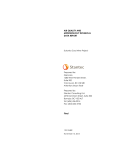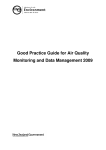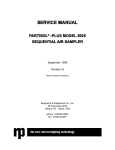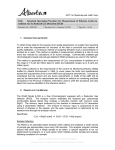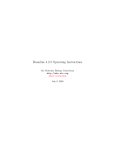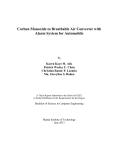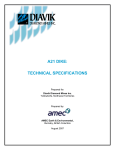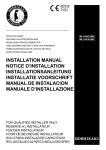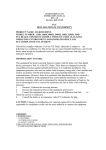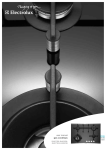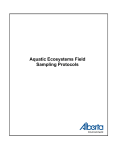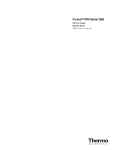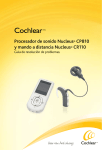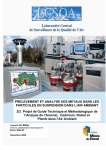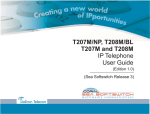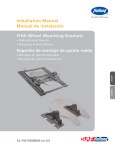Download Doris North Gold Mine Project: Air Quality Compliance Report for
Transcript
Hope Bay Mining Limited client logo Doris North Gold Mine Project: Air Quality Compliance Report for Section 4 Item 30 of the Project Certificate Engineers & Scientists Rescan™ Environmental Services Ltd. Sixth Floor - 1111 West Hastings Street Vancouver, BC Canada V6E 2J3 Tel: (604) 689-9460 Fax: (604) 687-4277 November 2009 DORIS NORTH GOLD MINE PROJECT AIR QUALITY COMPLIANCE REPORT FOR SECTION 4 ITEM 30 OF THE PROJECT CERTIFICATE Executive Summary Executive Summary The following atmospheric monitoring requirements are outlined in the Doris North Gold Mine Project Certificate (NIRB No. 003, issued September 15, 2006): 1. Section 4.0. Item 8. Newmont will fund and install a weather station at the mine site to collect atmospheric data, including air temperature and precipitation. The design and location of this station shall be developed in consultation with Environment Canada officials. 2. Section 4.0. Item 30. Newmont will install and fund an atmospheric monitoring station. This station and its location shall be developed in consultation with EC and HC air quality officials and focus on particulates of concern generated at the mine site. The results of air-quality monitoring are to be reported every 6 months to NIRB through the Monitoring Officer, and from there to all of the parties. 3. Commentary: NIRB expects that Canada Wide Standards for Dioxins and Furans and the Canada Wide Standards for Mercury will apply and should be followed including stack testing of incinerators. This report is intended to meet the requirements outlined in bullet 2 above. Separate reports will be submitted for the remaining bullets. In order to comply with Item 30 in Section 4.0 of the Project Certificate, Newmont Mining Corporation (Newmont) along with Rescan Environmental Services (Rescan) conducted the following activities in 2009: o Consulted with Mr. Dave Fox (Air Protection Management Analyst) of Environment Canada on the operation and location of the two Partisol samplers and the ambient air quality monitoring station prior to installation; o Collected measurements of particulates of concern, including both suspended particulate matter (by the use of 2 Partisol samplers which measured PM10, PM2.5 and TSP) and dustfall (5 dustfall monitoring stations); and o Collected measurements of ambient air quality, including sulphur dioxide, nitrogen dioxide, and ozone (SO2, NO2 and O3; by the use of 2 Passive Air Monitoring Systems (PASS)). Two continuous suspended particulate matter samplers (Partisol instruments manufactured by Thermo Fisher Scientific) and three dustfall collectors were installed in early summer 2009 to improve the previous ambient air quality monitoring program. The ambient air samplers (PASS) were installed in March 2009. The samples collected for particulate matter (PM10, PM2.5 and TSP), dustfall and SO2, NO2 and O3 were analyzed at an accredited laboratory. All parameters were compared with the Nunavut Environmental Guideline for Air Quality Sulphur Dioxide and Suspended Particulates, and the National Ambient Air Quality Objectives (NAAQOs) established under the Canadian Environmental Protection Act (CEPA). 2009 air quality monitoring results indicated that there were no exceedances for any of the monitored parameters, and results were indicative of background concentrations associated with undeveloped areas. HOPE BAY MINING LIMITED I DORIS NORTH GOLD MINE PROJECT AIR QUALITY COMPLIANCE REPORT FOR SECTION 4 ITEM 30 OF THE PROJECT CERTIFICATE Table of Contents DORIS NORTH GOLD MINE PROJECT: AIR QUALITY COMPLIANCE REPORT FOR SECTION 4 ITEM 30 OF THE PROJECT CERTIFICATE Table of Contents Executive Summary ......................................................................................................................................................................................I Table of Contents ....................................................................................................................................................................................... III List of Appendices.....................................................................................................................................................................IV List of Figures..............................................................................................................................................................................IV List of Tables ...............................................................................................................................................................................IV List of Plates ................................................................................................................................................................................IV Abbreviations and Definitions ...............................................................................................................................................................VI 1. Introduction ............................................................................................................................................................................ 1–1 2. Particulate Matter.................................................................................................................................................................. 2–1 2.1 Suspended Particulate Matter ......................................................................................................................... 2–1 2.1.1 2.1.2 2.1.3 2.2 Dustfall..................................................................................................................................................................... 2–7 2.2.1 Site Selection ........................................................................................................................................ 2–7 2.2.2 Monitoring Method............................................................................................................................ 2–7 2.2.3 3. Results and Comparison................................................................................................................... 2–9 Ambient Air Quality Monitoring by Passive Samplers.............................................................................................. 3–1 3.1 Site Selection ......................................................................................................................................................... 3–1 3.2 3.3 4. Site Selection ........................................................................................................................................ 2–1 Monitoring Method............................................................................................................................ 2–1 Results and Comparison................................................................................................................... 2–4 Monitoring Method............................................................................................................................................. 3–2 Results and Comparison .................................................................................................................................... 3–2 Results and Discussion ........................................................................................................................................................ 4–1 References................................................................................................................................................................................................. R–1 HOPE BAY MINING LIMITED III DORIS NORTH GOLD MINE PROJECT: AIR QUALITY COMPLIANCE REPORT FOR SECTION 4 ITEM 30 OF THE PROJECT CERTIFICATE List of Appendices Appendix 1. Suspended Particulate Matter Results (TSP, PM10 and PM2.5) Partisol Samplers Appendix 2. Passive Ambient Air Quality Results Appendix 3. Dustfall Analysis Results Appendix 4. Standard Operation Procedure for Partisol Ambient Air Quality Samplers List of Figures FIGURE PAGE Figure 2.1-1. Total Suspended Particulate (TSP), PM10 and PM2.5 Monitoring Station.................................................... 2–2 Figure 2.1-2. PM10/PM2.5 Sampler Simplified Diagram............................................................................................................... 2–5 Figure 2.2-1. New Dustfall Stations, Passive Samplers and Existing Dustfall Station ..................................................... 2–8 List of Tables TABLE PAGE Table 1.1-1. PM10 and PM2.5 Results.................................................................................................................................................. 2–6 Table 1.1-2. Total Suspended Particulate Results....................................................................................................................... 2–7 Table 1.2-1. Dustfall Results (New Stations).................................................................................................................................. 2–9 Table 1.2-2. Dustfall Results (Previously Installed Stations) ..................................................................................................2–10 Table 1.2-3. Dustfall Limits in Several Jurisdictions..................................................................................................................2–10 Table 2.3-1. Passive Ambient Air Quality Monitoring Results................................................................................................. 3–3 Table 2.3-2. Ambient Air Quality Limits ......................................................................................................................................... 3–3 List of Plates PLATE PAGE Plate 2.1-1. The Partisol ambient air samplers are located at the top of a butte that is approximately 660 m north of the Doris camp. Doris Lake is shown in the background of this photograph. ............................... 2–3 Plate 2.1-2. Temperature controlled shelter housing the Partisol ambient air samplers, late August 2009. ......... 2–3 Plate 2.1-3. Inside the temperature controlled shelter the Partisol sampler for TSP is shown on the left and the PM10/PM2.5 sampler is on right............................................................................................................................... 2–4 IV RESCAN ENVIRONMENTAL SERVICES LTD. (PROJ#1009-002-02/REV A.1) NOVEMBER 2009 TABLE OF CONTENTS Plate 2.1-4. The new Partisol air sampler filters are contained in a magazine on the left side of the unit. The filters laden with suspended particulate matter are contained in a magazine on the right side of the unit................................................................................................................................................................................. 2–6 Plate 2.2-1. Dustfall monitoring station three near the Doris project site. For locations using the ASTM (2004) method two sample containers are required to provide a sufficient volume of sample for the various parameters (e.g. particulate, anions, cations, total metals). Locations using the Alberta Environment (AMD 1989) method only require one collector. ............................................................................. 2–9 Plate 3.1-1. The white circular device shown in this photo is the passive air sampling system near the Doris automated meteorological station. ................................................................................................................................ 3–1 Plate 3.2-1. Passive air samplers under a rain shelter................................................................................................................ 3–2 V RESCAN ENVIRONMENTAL SERVICES LTD. (PROJ#1009-002-02/REV A.1) NOVEMBER 2009 DORIS NORTH GOLD MINE PROJECT AIR QUALITY COMPLIANCE REPORT FOR SECTION 4 ITEM 30 OF THE PROJECT CERTIFICATE Abbreviations and Definitions Abbreviations and Definitions Air Quality Standards Objectives for maximum concentrations of criteria air contaminants in the atmosphere developed to ensure long-tern protection of public health and the environment. Ambient Air Quality The outdoor air quality at particular site. ASTM American Society for Testing and Materials. BCMoE British Columbia Ministry of Environment. Criteria Air Contaminants Contaminants for which environmental regulatory agencies have established ambient air concentration limits. Fugitive Dust Particulate matter, often sand or mineral dust, released to the atmosphere by mechanical disruption of soil or by wind scouring. Inhalable particulate matter (PM10) PM10 particles are airborne particles that have a diameter of 10 μm or less and are thus a subset of total suspended particulate. The majority of PM10 particles are from fugitive dust sources. PM10 can enter the respiratory system and have been linked to health problems. Oxides of Nitrogen (NOx) NOx gas primarily consists of nitrogen oxide (NO) and nitrogen dioxide (NO2). The gases are emitted with exhaust from combustion engines and products from blasting operations. NOx can be converted to nitric acid in the atmosphere and thus contribute to acid deposition. Ozone (O3) A colorless, odorless reactive gas naturally found in the earth’s stratosphere, where it absorbs the ultraviolet component of incoming solar radiation that could be harmful to life on earth. It is also found near earth’s surface where pollutants emitted from human activities react in the presence of sunlight to form ozone. How sunny weather and stagnant conditions favor ozone formulation. The principal pollutants involved in these reactions are NOx, volatile organic carbon (VOC) and carbon monoxide (CO). Respirable particulate matter (PM2.5) PM2.5 particles are a subset of PM10 and are defined as particles with a diameter less than 2.5 μm. These particles are small enough to enter deep into the respiratory system. The majority of PM emitted in diesel engine exhaust is PM2.5. Sulphur Dioxide (SO2) Fossil fuel contains a small amount of organic compounds. During fuel combustion, the sulphur is oxidized and emitted as SO2 gas with the engine exhaust. In the atmosphere, SO2 can further oxidize to sulphate particles, which contribute to acid deposition. TSP Total suspended particulates (TSP) are solid matter or liquid droplets from smoke, dust, fuel ash, or condensing vapours that can be suspended in the air. USEPA United States Environmental Protection Agency. The USEPA has promulgated a variety of guidelines, objectives, emission factors, air dispersion modelling procedures and statutes for the protection of ambient air quality. HOPE BAY MINING LIMITED VI DORIS NORTH GOLD MINE PROJECT AIR QUALITY COMPLIANCE REPORT FOR SECTION 4 ITEM 30 OF THE PROJECT CERTIFICATE 1. Introduction 1. Introduction The following atmospheric monitoring requirements are outlined in the Doris North Gold Mine Project Certificate (NIRB No. 003, issued September 15, 2006): 1. Section 4.0. Item 8. Newmont will fund and install a weather station at the mine site to collect atmospheric data, including air temperature and precipitation. The design and location of this station shall be developed in consultation with Environment Canada officials. 2. Section 4.0. Item 30. Newmont will install and fund an atmospheric monitoring station. This station and its location shall be developed in consultation with EC and HC air quality officials and focus on particulates of concern generated at the mine site. The results of air-quality monitoring are to be reported every 6 months to NIRB through the Monitoring Officer, and from there to all of the parties. 3. Commentary: NIRB expects that Canada Wide Standards for Dioxins and Furans and the Canada Wide Standards for Mercury will apply and should be followed including stack testing of incinerators. This report is intended to meet the requirements outlined in bullet 2 above. Separate reports will be submitted for the remaining bullets. In order to comply with Item 30 in Section 4.0 of the Project Certificate, Newmont Mining Corporation (Newmont) along with Rescan Environmental Services (Rescan) conducted the following activities in 2009: o Collected measurements of particulates of concern, including both suspended particulate matter (by the use of 2 Partisol samplers) and dustfall (5 dustfall monitoring stations); and o Collected measurements of ambient air quality, including sulphur dioxide (SO2), nitrogen dioxide (NO2), and ozone (O3, by the use of 2 Passive Air Monitoring Systems (PASS)). As required in the Project Certificate, the locations for the instruments used to measure the above parameters along with the monitoring objectives were reviewed and approved by Mr. Dave Fox (Air Protection Management Analyst North, Environment Canada, Yellowknife). Chapter 2 of this report provides the results from the particulate matter (both suspended particulate matter and dustfall) measurements, and Chapter 3 of this report provides the results from the passive ambient air quality samplers for SO2, NO2 and O3. Chapter 4 provides a brief discussion of the results. HOPE BAY MINING LIMITED 1–1 DORIS NORTH GOLD MINE PROJECT AIR QUALITY COMPLIANCE REPORT FOR SECTION 4 ITEM 30 OF THE PROJECT CERTIFICATE 2. Particulate Matter 2. Particulate Matter Particulate matter is a criteria air quality contaminant (CAC) associated with mining and mineral processing operations. It is generated by mobile equipment, crushing, blasting, bulk handling and storage and other associated mineral processing and construction activities. As part of the ambient air quality compliance monitoring program, particulate matter was monitored in 2009 at various locations for the concentration of suspended particulate matter and dustfall. 2.1 SUSPENDED PARTICULATE MATTER Suspended particulate matter (SPM) in ambient air generally is a complex, multi-phase system of all airborne solid and low vapor pressure liquid particles having aerodynamic particle sizes from 0.01 to 100 μm in diameter and larger. SPM concentrations in ambient air were monitored using two Partisol samplers located on the butte near the Doris camp. The site selection, methods and results are presented below. 2.1.1 Site Selection As with any type of ambient air monitoring study, the validity of conclusions depends on representativeness of the sample data. Therefore, the sampling location and the siting of the ambient air samplers are important. Nunavut does not have established siting requirements for ambient air samplers. Therefore, the siting criteria from the British Columbia Ministry of Environment (BC MoE 2009) and the USEPA methods (USEPA 2009 and USEPA 1999) were used. Additional factors, not specified in standard site selection criteria, were also considered. Due to the very cold climate the Partisol samplers were installed inside a temperature controlled shelter. As a result the sample schedule interruptions potentially caused by cold weather, wet conditions and excess humidity (filter conditioning), air leaks and pump malfunctioning will be minimized. The Partisol air sampler location is free from obstructions and nearby pollutant sources that may cause interference in suspended particulate monitoring (Figure 2-1.1 and Plates 2-1.1 and 2.1-2). 2.1.2 Monitoring Method Suspended particulate matter is being monitored by the Partisol ambient air samplers in three forms; TSP, PM10 and PM2.5. The Partisol plus model 2025 ambient air sampler monitors TSP and the Partisol Sequential Dichotomous Model 2025D ambient air sampler monitors PM10 and PM2.5 simultaneously (Plate 2.1-3). The Partisol instruments are widely used in Canada for compliance monitoring programs and are recognized as reference equivalent methods by the USEPA (USEPA 2009). The Partisol ambient air samplers draw a particulate-laden ambient air stream through a size-selective inlet, and then through a 47 mm diameter filter. A built-in pump provides the vacuum required to pull the air flow through the sample filter and a volume flow controller monitors and automatically adjusts the flow rate (Figure 2.1-2). The filters, approved for use with the Partisol ambient air samplers, were the Pallflex TX40H120-WW teflon coated fibre glass type. The Partisol air sampler filters are pre and post weighted at a laboratory that is accredited by the Canadian Association for Laboratory Accreditation (CALA). HOPE BAY MINING LIMITED 2–1 PROJECT # 1009-002-02 GIS # HB-12-003 November 2 2009 50 ± 434000 15 0 10 0 50 150 7560000 50 7560000 433000 GF Partisol Ambient Air Samplers 50 7559000 7559000 Doris North Camp Doris Automated Meteorological Station 50 7558000 GF 7558000 Doris Lake Partisol Ambient Air Samplers ) Camp Location 500 7557000 7557000 1:15,000 250 100 ExistingQuarry Road A 0 50 Doris Automated Meteorological Station with Passive Air Sampling System and Dustfall Station (Alberta Method) Metres Projection: UTM13, NAD83 433000 434000 Location of Partisol Ambient Air Samplers for Total Suspended Particulate (TSP), PM10 and PM2.5 Figure 2.1-1 PARTICULATE MATTER Plate 2.1-1. The Partisol ambient air samplers are located at the top of a butte that is approximately 660 m north of the Doris camp. Doris Lake is shown in the background of this photograph. Plate 2.1-2. Temperature controlled shelter housing the Partisol ambient air samplers, late August 2009. HOPE BAY MINING LIMITED 2–3 DORIS NORTH GOLD MINE PROJECT: AIR QUALITY COMPLIANCE REPORT FOR SECTION 4 ITEM 30 OF THE PROJECT CERTIFICATE Plate 2.1-3. Inside the temperature controlled shelter the Partisol sampler for TSP is shown on the left and the PM10/PM2.5 sampler is on right. The filter exchange is performed using pneumatic pressure from the sample pump, and does not involve any special electromechanical components, belts or motors. New filter cassettes from the supply magazine (left) are pushed up and rightward to the sampling position, while the previous cassette is moved to the storage magazine (right, Plate 2.1-4). The supply and storage magazines are covered to seal off the filter cassettes thereby protecting them from environmental interferences during sampling operations. The Partisol Plus 2025 TSP sampler (the instrument on left at Plate 2.1-3) monitors only TSP therefore, the instrument does not split the incoming ambient air and all sampling air goes through one filter. The Partisol ambient air samplers at the Doris project are programmed to follow Environment Canada’s National Air Pollution Surveillance (NAPS) schedule. The NAPS program requires 24-hour sampling every six days for particulate matter monitoring. 2.1.3 Results and Comparison The ambient air quality sampling program for suspended particulate matter started on August 17, 2009. Table 2.1-1 summarizes the results from the Partisol 2025 Dichotomous sampler which provides ambient PM10 and PM2.5 concentrations. The PM10 and PM2.5 concentrations are representative of baseline conditions in an undisturbed remote area. There are no ambient air quality standards in Nunavut for PM10 and PM2.5 therefore the Canada-Wide Standards were used to compare PM2.5 and the British Columbia and Ontario standards for PM10. The Canada-Wide Standards were created by the Canadian Council for Ministers of the Environment (CCME). 2–4 RESCAN ENVIRONMENTAL SERVICES LTD. (PROJ#1009-002-02/REV A.1) NOVEMBER 2009 PROJECT # 1009-002-02 November 2, 2009 ILLUSTRATION # a24917f PM-10 Inlet (16.7 l/min) Virtual Impactor 1.7 l/min Coarse PM (PM10 - PM2.5) 15 l/min Fine PM (PM2.5) Filter Cassettes 5 l/min Flow controller 20 l/min Flow controller Pump Source: Thermo Fisher Scientific, 2007 Simplified Diagram for the Partisol Sequential Dichotomous Model 2025D Ambient Air Sampler Figure 2.1-2 DORIS NORTH GOLD MINE PROJECT: AIR QUALITY COMPLIANCE REPORT FOR SECTION 4 ITEM 30 OF THE PROJECT CERTIFICATE Plate 2.1-4. The new Partisol air sampler filters are contained in a magazine on the left side of the unit. The filters laden with suspended particulate matter are contained in a magazine on the right side of the unit. Table 2.1-1. PM10 and PM2.5 Results Summary Parameter Units 24-hr Limit PM10 PM2.5 μg/m3 μg/m3 50* 30** 17-Aug09 23-Aug09 29-Aug09 04-Sep09 10-Sep09 16-Sep09 22-Sep09 2.9 1.6 2.2 1.4 4.2 2.2 7.8 3.5 4.8 2.9 6.4 4.1 4.8 2.8 * British Columbia and Ontario ** Canada-Wide Standard based on 98 percentile Since the program was recently initiated, there are only seven sampling results and therefore a definitive trend for particulate matter concentration cannot be discerned. The next 6 month reporting period will provide sufficient data to be able to determine if there is a trend of increasing, decreasing or steady particulate matter concentrations at the site. Table 2.1-2 summarizes the results from the Partisol Plus 2025 sampler which monitors TSP concentrations. None of the 24 hour TSP concentrations exceeded the Health Canada - National Ambient Air Quality Objective (NAAQO) or the Nunavut Environmental Guideline for Air Quality. Overall, the results are lower than expected because the TSP concentrations should be higher than the PM10 and PM2.5 concentrations. PM10 and PM2.5 are subsets of TSP and the TSP sampler should be collecting all PM with an approximate aero dynamic diameter of 100 μm or less. The cause of these lower than normal TSP concentrations is currently being investigated. 2–6 RESCAN ENVIRONMENTAL SERVICES LTD. (PROJ#1009-002-02/REV A.1) NOVEMBER 2009 PARTICULATE MATTER Table 2.1-2. Total Suspended Particulate (TSP) Results Summary Sampling Date TSP Units 24-hr Limit μg/m 120* 3 17-Aug09 23-Aug09 29-Aug09 4-Sep09 10-Sep09 16-Sep09 22-Sep09 1.6 1.8 2.3 1.8 1.2 1.2 0.9 * 24-hr limit specified in Canadian Ambient Air Quality Objective and the Nunavut Environmental Guideline for Air Quality 2.2 DUSTFALL The purpose of the dustfall monitoring program is to quantify the amount of dust deposition near to the Doris North project site and compare the results to the available criteria and standards. Two dustfall monitoring stations began collecting data in March 2009. Three new dustfall monitoring stations were established early July 2009. The first two dustfall stations are collocated with meteorological stations at Doris and Boston. The dustfall results have been prorated by the laboratory to a 30-day average, so that they can be compared with the standards. The first two existing dustfall stations use an Alberta Environment method (Alberta AMD 1989), and the remaining three stations use the ASTM 2004 method. 2.2.1 Site Selection The two existing dustfall monitoring stations are located at the Doris North and Boston automated meteorological stations. Three new dustfall stations were installed in the vicinity of Doris camp (Figure 2.2-1) following the ASTM 2004 site selection recommendations. The dominant wind directions as well as present and future project activities were considered during the site selection process. There are no obstructions or local sources of air pollutants near the new stations. In addition, the topography is very convenient to collect representative data (Figure 2.2-1). The dustfall monitoring stations are in open areas that are free of structures higher than 1 m within a 20 m radius of the collection container. 2.2.2 Monitoring Method Dustfall (settleable particulate matter) was monitored at the three new dustfall monitoring stations by using the ASTM D1739-98 method (ASTM 2004). The dustfall monitoring stations collect particles small enough to pass through a 1 mm screen and large enough to settle by virtue of their weight. This method requires containers of a standard size and shape which are sealed in a laboratory. The containers are opened and installed inside of a wind screen for about 30 days. Monthly samples were sent to the laboratory for analysis of total, soluble and insoluble particulate matter. There were two dustfall collectors at each new dustfall station. One of the containers measured particulates (total, soluble and insoluble) and anions (sulphate, nitrate, chloride, and ammonia) and the other measured total metals and various cations. Because algae are an interference for the dustfall measurement the deionized water in the dustfall containers also contains algaecide. The wind screen around the sample container improves the dustfall collection efficiency and bird spikes are used to minimize contaminants from bird droppings (Plate 2.2-1). The two original dustfall stations were operated by using the Alberta Environment method (Alberta AMD 1989). Each station consisted of one dustfall collector. Monthly samples were sent to the laboratory for analysis of total dustfall and total fixed dustfall. Total dustfall is defined as the amount of material left after evaporation of a sample of dustfall and its subsequent drying. Total fixed dustfall is the residue that is left after ignition of the total dustfall sample (AMD 1989). HOPE BAY MINING LIMITED 2–7 GIS # HB-12-004 November 2 2009 437500 50 DF1 50 50 50 50 50 50 7562500 435000 50 ± 432500 GF 430000 7562500 PROJECT # 1009-002-02 50 50 50 50 50 50 50 50 7560000 50 50 1 150 00 7560000 50 100 50 Doris Camp 50 50 50 50 50 50 50 50 50 7557500 GF 50 DF2 Doris Automated Meteorological Station 7557500 50 50 50 50 150 10 0 50 50 50 50 50 50 50 50 Metres 50 DF3 432500 435000 437500 Figure 2.2-1 Dustfall and Passive Air Quality Monitoring Stations 7552500 50 50 2,000 GF GF 7555000 50 50 50 50 Existing Road Projection: UTM13, NAD83 430000 50 50 Camp Location 1:50,000 1,000 50 50 50 50 50 0 50 50 50 ) 50 50 50 Dustfall Monitoring Station (July 2009) Doris Automated Meteorological Station with Passive Air Sampling System and Dustfall Station (Alberta Method) 7552500 50 50 50 7555000 50 50 50 PARTICULATE MATTER Plate 2.2-1. Dustfall monitoring station three near the Doris project site. For locations using the ASTM (2004) method two sample containers are required to provide a sufficient volume of sample for the various parameters (e.g. particulate, anions, cations, total metals). Locations using the Alberta Environment (AMD 1989) method only require one collector. 2.2.3 Results and Comparison The dustfall results and standards are summarized in Table 2.2-1 and Table 2.2-2, respectively. Table 2.2-3 summarizes the dustfall limits in various jurisdictions. There is no consistency in dustfall limits among various authorities and jurisdictions. Overall the Doris project dustfall results were lower than any of the limits listed in Table 2.2-3. This was expected and indicates typical baseline levels for an undisturbed area. The concentration of total metals in the dustfall samples was also analyzed and the laboratory results are in Appendix III. The results indicate that most of the total metal concentrations were below the detection limit. Table 2.2-1. Dustfall Results using the ASTM method (mg/dm2/day) Dustfall DF1 DF2 DF3 Jul-2009 Aug-2009 Jul-2009 Aug-2009 Jul-2009 Aug-2009 0.19 < DL 0.15 0.13 < DL 0.13 0.23 < DL 0.19 0.12 < DL 0.13 0.13 < DL 0.12 < DL < DL 0.11 Total Total Insoluble Total Soluble Note : < DL = Less than the detection limit of 0.10 mg/dm2/ day HOPE BAY MINING LIMITED 2–9 DORIS NORTH GOLD MINE PROJECT: AIR QUALITY COMPLIANCE REPORT FOR SECTION 4 ITEM 30 OF THE PROJECT CERTIFICATE Table 2.2-2. Dustfall Results using the Alberta Environment method (mg/dm2/day) Doris Station Doris Total Dustfall Doris Total Fixed Dustfall Boston Station Boston Total Dustfall Boston Total Fixed Dustfall Mar-2009 0.073 0.023 Apr-2009 0.097 0.073 May-2009 0.093 0.023 Jun-2009 0.153 0.100 Jul-2009 0.213 0.190 Aug-2009 0.473 0.437 Sep-2009 * * 0.123 0.050 0.160 0.113 0.137 0.070 0.190 0.150 0.160 0.113 0.467 0.467 0.227 0.227 * Not available yet. Table 2.2-3. Dustfall Limits in Several Jurisdictions Jurisdiction Dustfall Criterion Level (mg/m2/day) Comments Dustfall Criterion Level (mg/dm2/day) 175 averaged over 30 days 1.75 525 averaged over 30 days 5.25 Alberta residential and recreational areas commercial and industrial areas Ontario 230 averaged over 30 days 2.3 Australia (new mines) 130 pro-rata compensation if level exceeded total compensation if level exceeded 1.3 95th percentile complaints likely if exceeded 96th percentile complaints likely if exceeded 97th percentile complaints likely if exceeded 1.0 330 United Kingdom open country 100 residential areas 150 commercial areas 190 3.3 1.5 1.9 New York Level I Level II Level III Level IV British Columbia Pollution Control Objective (BC MOE 1979) 100 100 130 200 170 to 290 1.0 1.0 1.3 2.0 1.7 to 2.9 Source: Hrebenyk & Enns 2005 (except for the BC Pollution Control Objectives) The total metal concentrations that were not below the detection limits were very low and for all intents and purposes would be considered negligible. There are no specific criteria for total metals in environmental dustfall. However, there is workplace or occupational air quality standards (e.g., industrial hygiene) for metals that are of concern with respect to human health. The metals that are a concern for human health are cadmium, lead and arsenic. The concentrations of total arsenic in the dustfall samples were below the detection limit in August but just above the limit of detection in July. The concentrations of total cadmium and lead in the dustfall samples were negligible. 2–10 RESCAN ENVIRONMENTAL SERVICES LTD. (PROJ#1009-002-02/REV A.1) NOVEMBER 2009 DORIS NORTH GOLD MINE PROJECT AIR QUALITY COMPLIANCE REPORT FOR SECTION 4 ITEM 30 OF THE PROJECT CERTIFICATE 3. Ambient Air Quality Monitoring by Passive Samplers 3. Ambient Air Quality Monitoring by Passive Samplers Starting in March 2009, the passive ambient air quality samplers obtained monthly average concentrations for criteria air contaminants at the Project site. Passive ambient air samplers were collocated with the Boston and Doris automated meteorological stations and monitored SO2, NO2 and O3 (Figure 2.2-1). 3.1 SITE SELECTION The samplers (Plate 3.1-1) were placed in environmentally safe locations where they would not be affected by weather or damaged by wildlife. They were placed far from obstructions and there were no nearby roadways that could influence measurements. One sampler was located near the Doris meteorological station (Figure 2.2-1) and the other was located near the Boston meteorological station. Plate 3.1-1. The white circular device shown in this photo is the passive air sampling system near the Doris automated meteorological station. HOPE BAY MINING LIMITED 3–1 DORIS NORTH GOLD MINE PROJECT: AIR QUALITY COMPLIANCE REPORT FOR SECTION 4 ITEM 30 OF THE PROJECT CERTIFICATE 3.2 MONITORING METHOD Passive air sampling is a diffusive method which monitors gas or vapor pollutants from the atmosphere at a rate controlled by a physical process, such as diffusion through a static air layer or permeation through a membrane. The passive method does not involve the active movement of the air through the sampler; therefore no electric air moving pump is required. The number of days of contact between the ambient air and the permeation membrane is important. The local meteorological conditions are also used in the calculations. The meteorological parameters that are used in the PASS calculations are air temperature, wind speed and relative humidity. The passive air monitoring sampling system (PASS) provides low detection limits, is very easy to install and does not require power. The passive sampler is kept under a rain shelter (Plate 3.2-1) on a tripod beside the Doris meteorological station. The other PASS monitoring site is located at the Boston meteorological station. Duplicate PASS samplers are collected at the Boston station. Plate 3.2-1. Passive air samplers under a rain shelter. 3.3 RESULTS AND COMPARISON Monthly PASS samples were analyzed at Maxxam Analytical Laboratory. The PASS results and standards are summarized in Table 3.3-1 and Table 3.3-2, respectively. The original laboratory reports are in Appendix II. The PASS results are expressed as monthly average concentrations; however Health Canada’s National Ambient Air Quality Objectives (NAAQO) and the Nunavut Environmental Guideline for Air Quality only use averaging periods of 1-hour, 24-hour and 1-year. Therefore the PASS results cannot be directly compared with the Canadian and Nunavut ambient air quality objectives or guidelines. After a full year of PASS data has been collected, it will be possible to compare with the annual limit in the NAAQO and Nunavut guidelines. 3–2 RESCAN ENVIRONMENTAL SERVICES LTD. (PROJ#1009-002-02/REV A.1) NOVEMBER 2009 AMBIENT AIR QUALITY MONITORING BY PASSIVE SAMPLERS Overall the concentrations of SO2, NO2 and O3 were low and representative of baseline concentrations in an undisturbed area. Duplicate PASS samples are collected at the Boston station. During June 2009 there was a discrepancy between the two results for ozone. The ozone concentration for the first PASS sampler was 20.7 ppb but below the detection limit (0.1 ppb) for the second PASS sampler. The sample that was below the detectable limit was eliminated from the data set because 20.7 ppb is more representative of the baseline ozone concentrations at the Boston station. Table 3.3-1. Passive Ambient Air Quality Monitoring Results Doris Station Parameter Sampling Period Units Mar-2009 Apr-2009 May-2009 Jun-2009 Jul-2009 Aug-2009 μg/m3 ppb μg/m3 ppb μg/m3 ppb < DL < DL 3.0 1.6 1.4 0.7 < DL < DL 0.4 0.2 60.2 30.7 < DL < DL 0.8 0.4 79.6 40.6 0.3 0.1 < DL < DL 55.9 28.5 < DL < DL 0.2 0.1 40.6 20.7 < DL < DL 0.6 0.3 39.4 20.1 μg/m3 ppb μg/m3 ppb μg/m3 ppb 0.2 0.1 0.2 0.1 65.6 33.5 < DL < DL 5.6 3.0 50.2 25.6 < DL < DL 1.9 1.0 57.5 29.3 < DL < DL 0.2 0.1 40.6 20.7 < DL < DL < DL < DL 39.6 20.2 < DL < DL 0.6 0.3 38.2 19.5 SO2 NO2 O3 Boston Station1,2 Parameter SO2 NO2 O3 < DL = Less than the detection Limit Detection limits are (0.1 ppb) (0.26 ug/m3) for SO2, 0.1 ppb (0.188 ug/m3) for NO2 and 0.1 ppb (0.196 ug/m3) for O3. Note 1 = The average of two samples are presented in the Table 2.3-1 above. Note 2 = If one of the samples below detection limit and the other sample is in detectable limit, the undetectable concentration was assumed as half of the detection limit (0.05 ppb) in average calculations. Table 3.3-2. Ambient Air Quality Limits SO2 * NO2 ** O3 ** Unit Annual Daily 1-Hour μg/m3 μg/m3 μg/m3 30 60 30 150 200 30 450 300 100 * Nunavut Environmental Guideline for Air Quality ** National Ambient Air Quality Objectives (NAAQOs) established and reviewed based on recommendations under the Canadian Environmental Protection Act (CEPA) Although direct comparisons cannot be made between the monthly PASS results and the NAAQO and Nunavut air quality guidelines due to the different averaging periods some general observations can be made. The ozone concentrations at Doris and Boston were lower than the 1-hour NAAQO. They were also lower than the CCME - Canada-Wide Standard which has an 8-hour limit of 65 ppb (127 μg/m3) for the 4th highest value. However, Health Canada’s National Ambient Air Quality Objectives (NAAQO) for HOPE BAY MINING LIMITED 3–3 DORIS NORTH GOLD MINE PROJECT: AIR QUALITY COMPLIANCE REPORT FOR SECTION 4 ITEM 30 OF THE PROJECT CERTIFICATE Ground-level Ozone suggests that the average background ozone concentrations are 25 to 40 ppb for a monthly average (Health Canada 1999). The ozone concentrations at the site ranged from 0.7 to 40.6 ppb and roughly one half of the ozone concentrations at Doris and Boston were lower than Health Canada‘s suggested range for background ground-level ozone concentrations. These observations are only based on 6 months of data collection and future data will add to the robustness of the data set and allow for a more accurate comparison. 3–4 RESCAN ENVIRONMENTAL SERVICES LTD. (PROJ#1009-002-02/REV A.1) NOVEMBER 2009 DORIS NORTH GOLD MINE PROJECT AIR QUALITY COMPLIANCE REPORT FOR SECTION 4 ITEM 30 OF THE PROJECT CERTIFICATE 4. Results and Discussions 4. Results and Discussion The ambient air quality monitoring program at the Doris project site was substantially improved during the summer of 2009. The two previously installed passive ambient air monitoring and dustfall stations remained the same and three new dustfall stations were installed. In addition, two Partisol ambient air quality samplers were installed to monitor TSP, PM10 and PM2.5. The Partisol sampler and program follows the Environment Canada – National Air Pollutant Surveillance (NAPS) schedule and allows for collection of a 24-hr sample every six days. The Partisol program was initiated in mid August 2009 and there were seven results included in this report. The PM10 and PM2.5 concentrations at the Doris site were typical of background concentrations for a remote undisturbed area in Canada and they were lower than the Health Canada – National Ambient Air Quality Objectives, Canada-Wide Standards and Nunavut Environmental Guideline for Air Quality. The total suspended particulate matter concentrations at the Doris site were lower than expected; therefore, the ambient air sampler with undergo an operational check. It is possible that a leak in the system may have caused the lower than normal concentrations. A second possible cause could be an error in the pre and post weighing of the Partisol air sampler filters at the analytical laboratory. Three new dustfall stations were installed near the Doris site according to the ASTM 1739-98 method (reapproved in 2004). The two original dustfall stations used the 1985 Alberta Air Monitoring Directive Method. The monthly dustfall values were all below dustfall criteria in various jurisdictions. The maximum recorded dustfall concentration of 0.23 mg/dm2/day (July 2009 at DF2) was below the Alberta limit (5.25 mg/dm2/day) and British Columbia limit (1.7 to 2.3 mg/dm2/day). The passive ambient air quality monitoring program included monthly sampling for SO2, NO2 and O3. The maximum observed concentrations were 0.1, 3.0 and 40.6 ppb for SO2, NO2 and O3 respectively. The background concentrations were representative of a remote undisturbed area. Because of different averaging periods the PASS results (monthly average) cannot be directly compared with the Nunavut Environmental Guideline for Air Quality or Health Canada’s National Ambient Air Quality Objectives – NAAQO (annual, 24-hour and 1-hour averages). Generally the monthly average ozone concentrations at the Doris site were in the range of background concentrations recommended by Health Canada, 1999 (25 to 40 ppb monthly average). Additional future data will provide for more useful comparisons to be made. After one year of PASS data has been collected it will be possible to calculate an annual average for direct comparisons with the Nunavut Guidelines and Health Canada’s NAAQO. The ambient air quality monitoring program at the Doris site will continue with the collection of TSP, PM10 and PM2.5 samples for 24-hr every 6 days, and monthly dustfall monitoring and passive air sampling for SO2, NO2 and O3. HOPE BAY MINING LIMITED 4–1 DORIS NORTH GOLD MINE PROJECT AIR QUALITY COMPLIANCE REPORT FOR SECTION 4 ITEM 30 OF THE PROJECT CERTIFICATE References References Alberta Environment. 1989 (amended in 2006). Air Monitoring Directive (AMD) Appendix A-6 Determination of Dustfall, Edmonton, AB. American Society for Testing and Materials (ASTM). 2004. Standard Test Method for Collection and Measurement of Dustfall (Settleable Particulate Matter) Designation D 1739-98 Reapproved 2004, West Conshohocken, PA. British Columbia Ministry of Environment (BCMoE). 1979. Pollution Control Objectives for the Mining, Smelting and Related Industry of British Columbia. Victoria, BC. British Columbia Ministry of Environment (BCMoE). 2009. Air Monitoring Site Selection and Exposure Criteria, Victoria, BC. Canadian Council of Ministers of the Environment, (CCME). 2000. Canada-Wide Standards for Particulate Matter (PM) and Ozone, Canadian Council of Ministers of the Environment, Quebec City, QC. Health Canada. 1999. National Ambient Air Quality Objectives for Ground-Level Ozone, Federal-Provincial Working Group on Air Quality Objectives and Guidelines, Ottawa, ON. Hrebenyk and Enns. 2005. Peer Review of Diavik Diamond Mine Air Quality Monitoring Program. Report prepared for Environmental Monitoring Advisory Board, Yellowknife, NWT. Nunavut Government. 2002. Environmental Guideline for Air Quality – Sulphur Dioxide and Suspended Particulates. Government of the Nunavut, Environmental Protection Service, Department of Sustainable Development, Iqaluit, NU. US Environmental Protection Agency (US EPA). 1999. Compendium Method IO-2.3 Sampling of Ambient Air for PM10 Concentration Using the Rupprecht and Patashnick (R&P) Low Volume Partisol Sampler. Center for Environmental Research Information – Office of Research and Development, Cincinnati, OH. US Environmental Protection Agency (US EPA). 2009. Title 40: Protection of Environment Part 58Ambient air Quality Surveillance, Subpart G - Federal Monitoring Appendix E – Probe and Monitoring Path Siting Criteria for Ambient Air Quality Monitoring, Research Triangle Park, NC. HOPE BAY MINING LIMITED R-1 DORIS NORTH GOLD MINE PROJECT AIR QUALITY COMPLIANCE REPORT FOR SECTION 4 ITEM 30 OF THE PROJECT CERTIFICATE Appendix 1 Suspended Particulate Matter Results (TSP, PM10 and PM2.5) Partisol Samplers DORIS NORTH GOLD MINE PROJECT AIR QUALITY COMPLIANCE REPORT FOR SECTION 4 ITEM 30 OF THE PROJECT CERTIFICATE Appendix 2 Passive Ambient Air Quality Results DORIS NORTH GOLD MINE PROJECT AIR QUALITY COMPLIANCE REPORT FOR SECTION 4 ITEM 30 OF THE PROJECT CERTIFICATE Appendix 3 Dustfall Analysis Results DORIS NORTH GOLD MINE PROJECT AIR QUALITY COMPLIANCE REPORT FOR SECTION 4 ITEM 30 OF THE PROJECT CERTIFICATE Appendix 4 Standard Operation Procedure for Partisol Ambient Air Quality Samplers STANDARD OPERATING PROCEDURE (SOP) FOR HOPE BAY BELT PROJECT – BASELINE AMBIENT AIR QUALITY MONITORING FOR PARTICULATE MATTER (TSP, PM10 and PM2.5) Project # 1009-002-02 Thermo 2025 D Sequential Dichotomous Partisol®-Plus Thermo 2025 Partisol®-Plus TABLE OF CONTENTS 1. FILTER HANDLING, EXCHANGE and SHIPPING ............................................................................................................. 1-1 1.1 1.2 2. SOFTWARE OVERVIEW.............................................................................................................................................................. 5 2.1 2.2 2.3 3. Preparing the Filter Cassette Magazine......................................................................................................... 1-1 Installing a Filter Cassette Magazine .............................................................................................................. 1-1 Modes of Operation ................................................................................................................................................. 5 Basic Filter Setup Screen......................................................................................................................................... 6 Operation After Power Failure.............................................................................................................................. 9 SECTION 3 - AUDIT ...................................................................................................................................................................10 3.1 Leak Check.................................................................................................................................................................10 3.2 Flow Verification......................................................................................................................................................11 List of Appendices APPENDIX A Partisol Ambient Air Sampler Maintenance Record and Template for Calibration APPENDIX B Environment Canada NAPS Schedule APPENDIX C Example Chain of Custody for Maxaam Analytics List of Plates PLATE PAGE Plate 1.1-1. Placing filter cassettes in a magazine. ...................................................................................................................... 1-1 Plate 1.2-1. Thermo Partisol 2025 TSP Sampler............................................................................................................................ 1-2 Plate 1.2-2. Transport Container (left) and placing the magazine (right)............................................................................ 1-2 Plate 1.2-3. Cassette serial numbers to be recorded and entered in the software. ......................................................... 1-3 Plate 1.2-4. The sampling inlets (TSP on left and PM10/PM2.5 on right)............................................................................. 1-3 Plate 2.1-1. Stand-by screen display..................................................................................................................................................... 5 Plate 2.1-2. Partisol Keypad..................................................................................................................................................................... 6 Plate 2.1-3. Filter information screen................................................................................................................................................... 6 Plate 2.2-1A. 2025D Sequential Dichotomous ambient air quality sampler - Left side magazine loaded with new filters and right side magazine for used filters. The front magazines are for PM10 and the back magazines are for PM2.5........................................................................................................................................ 7 Plate 2.2-1B Main Screen........................................................................................................................................................................... 7 HOPE BAY MINING LTD. i STANDARD OPERATING PROCEDURE (SOP) FOR HOPE BAY BELT PROJECT – BASELINE AMBIENT AIR QUALITY MONITORING FOR PARTICULATE MATTER (TSP, PM10 AND PM2.5) Plate 2.2-2 The sample information screen (after <f3> filtsetup on main screen) ................................................................ 8 Plate 2.3-1. Thermo 2025 TSP Sampler. The left hand magazine contains new filters and the right hand magazine contains used filters. ............................................................................................................................................. 9 Plate 3.1-1. Flow audit adapter. ...........................................................................................................................................................10 Plate 3.2-1. Sample tube and the flow verifier................................................................................................................................11 ii RESCAN ENVIRONMENTAL SERVICES LTD. (PROJ#1009-002-02) (REV 0.2) October 2009 1. FILTER HANDLING, EXCHANGE and SHIPPING 1.1 PREPARING THE FILTER CASSETTE MAGAZINE Place the filters (in cassettes) coming from the laboratory into an empty magazine. These Teflon filters (47 mm diameter, Pull flex TX-40) were pre-weighted at the laboratory and placed in numbered cassettes. The metal part should be facing down when you are placing cassettes in the magazines. (Plate 1.1-1). Plate 1.1-1. Placing filter cassettes in a magazine. 1.2 INSTALLING A FILTER CASSETTE MAGAZINE There are 2 Thermo Scientific Partisol ambient air quality samplers for suspended particulate matter monitoring in the shelter. When you open the doors, the sampler on the left hand side is being used for total suspended particulate (TSP) sampling (Partisol Plus 2025 TSP Sampler) and the width of this sampler is relatively smaller than the other one and this width difference can be distinguished by eye. The instrument has one sampling compartment which uses two magazines (Plate 1.2-1). The left hand side will contain unused filter cassettes and the used filters will be stored on the right hand side. hope bay mining ltd. 1-1 STANDARD OPERATING PROCEDURE (SOP) FOR HOPE BAY BELT PROJECT – BASELINE AMBIENT AIR QUALITY MONITORING FOR PARTICULATE MATTER (TSP, PM10 AND PM2.5) Plate 1.2-1. Thermo Partisol 2025 TSP Sampler. New filter cassettes are always placed in the left magazine, and the used filter cassettes in the right hand side magazine. Remove the tubing connected to the bottom of both magazines; the metal clip on the tubing should be pressed to unlock the connection. No tools are necessary for this change out. Remove the existing magazines by pushing gently up and than moving counter clockwise until it releases itself and place the magazine, which contains used filters, in a transport container (Plate 1.22). Plate 1.2-2. Transport Container (left) and placing the magazine (right). After securing the samples (filter loaded cassettes) in transport container, install the new magazine (which contains the unused filter cassettes) by matching the notches in the filter cassette magazine with the mounting studs on the sampler. Push the magazine upward and rotate clockwise to lock it into place. Ensure that the cassette magazines are labeled prior to installation in the sampler because there are different magazines that sample different types of particulate matter – for this sampler all samples are for total suspended particulate (TSP). Record the serial numbers of the cassettes (Plate 1.2-3) in the 1-2 RESCAN ENVIRONMENTAL SERVICES LTD. (PROJ#1009-002-02) (REV 0.2) October 2009 FILTER HANDLING, EXCHANGE AND SHIPPING order you placed them in the magazine. The filter numbers will be entered in the software program by using the LCD screen. Instructions for the software program are available below in Section 2. Plate 1.2-3. Cassette serial numbers to be recorded and entered in the software. The other Partisol ambient air quality sampler (Partisol PLUS Sequnetial Dichotomous Model #2025D) is located on the right hand side of the enclosure. This Partisol had 2 compartments because it samples both PM10 and PM2.5. These compartments have identical functionality with the Partisol 2025 TSP sampler. The difference is the PM10 inlet (Plate 1.2-4) at the end of the + 2 meter high sampling tubes above the roof of the outdoor enclosure. Plate 1.2-4. The sampling inlets (TSP on left and PM10/PM2.5 on right). hope bay mining ltd. 1-3 1-3 STANDARD OPERATING PROCEDURE (SOP) FOR HOPE BAY BELT PROJECT – BASELINE AMBIENT AIR QUALITY MONITORING FOR PARTICULATE MATTER (TSP, PM10 AND PM2.5) Fill out the chain of custody with sampling date and volumes and send the filter cassettes in a weather proof hard case to; Maxxam Analytics Hope Bay Project (1009-002-02) – Partisol Filters 9331 - 48 Street, Edmonton, Alberta T6B 2R4 Tel: (780) 577-7100 1-4 RESCAN ENVIRONMENTAL SERVICES LTD. (PROJ#1009-002-02) (REV 0.2) October 2009 2. SOFTWARE OVERVIEW 2.1 MODES OF OPERATION Plate 2.1-1 summarizes the information displayed on the first “page” of the LCD screen. However, the flow rate will be 16.7 l/min for the Partisol 2025 TSP sampler and 15 / 1.67 l/min for the Sequential Dichotomous 2025D (PM2.5/ PM10) sampler. The mode will be “Wait” because this Project follows the NAPS (National Air Pollution Surveillance) schedule from Environment Canada. This means that the air samplers will work 24 hours every 6 days therefore if you don’t visit during a 24-hr sampling period, you will always see the “wait” mode displayed. Plate 2.1-1. Stand-by screen display. Navigating among screens is done using the keypad. In order to edit, you should switch to “Stop” mode from “Wait” mode, which is displayed on top right corner of the screen, by using run/stop button on the left bottom button on the keypad (Plate 2.1-2). Since the software is already programmed, the user will only use the instrument to enter filter names. Always remember to swith “wait” mode by pressing lower-left button (Run/Stop) before leaving the shelter, otherwise the system will not operate and partisol sampler will be on standby mode. Once samples are collected in the right hand side filter magazine, make sure to fill in the data sheet in Appendix A and send it to the laboratory with the samples and the chain of custody. To determine the actual total volume of air sampled (m3) press <F4> Data and then press “filter data screen”. Plate 2.1-3 summarizes the sampling data for filter “P 123456” with an actual sampled volume of 6 m3 on Apr 11, 1999. This information is to be filled in Appendix A form for laboratory calculations. The filters will be weighted at the accredited laboratory (Section 1.2), and the actual volume of air sampled will enable the laboratory staff to calculate the mass concentration of particulate matter in ambient air. hope bay mining ltd. 5 STANDARD OPERATING PROCEDURE (SOP) FOR HOPE BAY BELT PROJECT – BASELINE AMBIENT AIR QUALITY MONITORING FOR PARTICULATE MATTER (TSP, PM10 AND PM2.5) Plate 2.1-2. Partisol Keypad. Plate 2.1-3. Filter information screen. 2.2 BASIC FILTER SETUP SCREEN The Partisol ambient air quality sampling schedule is synchronized with Environment Canada NAPS. The 2009 NAPS schedule is provided in Appendix B. NAPS requires 24-hour sampling every 6 days. This sample frequency is already programmed in both Partisols therefore no further programming is necessary. The memory keeps the sampling program even there is a power failure. After removing the magazine full of used filters and installing a magazine of new filters (Plate 2.2-1), the new filter numbers should be entered on the field data sheet (Appendix A) in order to get statistical data in the future, such as actual total volume of air sampled. 6 RESCAN ENVIRONMENTAL SERVICES LTD. (PROJ#1009-002-02) (REV 0.2) October 2009 SOFTWARE OVERVIEW Plate 2.2-1A. 2025D Sequential Dichotomous ambient air quality sampler - Left side magazine loaded with new filters and right side magazine for used filters. The front magazines are for PM10 and the back magazines are for PM2.5. To enter filter names (numbers), press setup <F5> on the main screen (Plate 2.2-1B). (If you think you’re not on the main screen, please press ESC button until you reach the main screen). Plate 2.2-1B Main Screen Then select the filter list setup screen, you will see a list to be edited. Press the edit button and enter the name (number) of new filters in order. Remember that last filter you put in the magazine will be number 1 in this list. hope bay mining ltd. 77 STANDARD OPERATING PROCEDURE (SOP) FOR HOPE BAY BELT PROJECT – BASELINE AMBIENT AIR QUALITY MONITORING FOR PARTICULATE MATTER (TSP, PM10 AND PM2.5) You should also remind that front magazines are for coarse particulates (PM10 minus PM2.5) and rear magazines are for fine particulates (PM2.5). The same types of filters are used for both the PM10 and PM2.5 sampling. The only important point is to record which ones were at the rear (PM2.5) and at the front (PM10) in the form at Appendix A. Make sure you know the order of filters installed in magazine so if you made a mistake entering a filter name, data can be gathered by using date and time data. The easiest way of gathering data is to take pictures of records on the screen (Plate 2.2-2). As it is seen on Plate 2.2-2, the 6th filter in the magazine was sampled on September 22, 2009 with a total volume of 25.4 m3. Plate 2.2-2 The sample information screen (after <f3> filtsetup on main screen) The TSP model 2025 Partisol PLUS sampler has only one compartment (Plate 2.3-1). Both Partisol samplers have the same system for organizing the filters in the left magazine contains new filters and right magazine contains (or will contain) used filters. As a summary, the operation needs attention to 2 important factors. 1. Taking the used filters with their sampling date and total volume. 2. Installing new filters and recording their filter names in order Your shelter visit will be step by step as the following; - Never visit the shelter during an operation day (NAPS scheduled) because the sampler is running. - Take the used filters and write down on the magazine their compartment (TSP, Coarse-PM10 or FinePM2.5). - Take pictures of the sampling records (see example as in Plate 2.2-2) - Install new magazines and don’t forget to hook up air pumping tubing. - Press <Run/Stop> button on left bottom corner of the keypad, and than once you see “Stop” on right top corner of the LCD screen, enter filter names. And than make sure pressing <Run/Stop> button and see “Wait” mode on the screen before you leave. 8 RESCAN ENVIRONMENTAL SERVICES LTD. (PROJ#1009-002-02) (REV 0.2) October 2009 SOFTWARE OVERVIEW 2.3 OPERATION AFTER POWER FAILURE In the event of a power failure settings are not changed, the operation will continue when power comes back. The system lots a “Z” condition to mark the power failure. Depending upon how much time has passed, the unit will perform a filter exchange until it reaches the next filter scheduled to sample. It then either begins sampling or enters the Wait Operating Mode to await the start of the next sequential sample. If the unit begins sampling, the “Z” status condition will be retained in the current record of filter data. However, if the unit enters the Wait Operating Mode, the unit will automatically clear the “Z” status condition. Therefore, the operator does not need to make any special programming changes but has to record the power failure date and time in the form in Appendix A. Plate 2.3-1. Thermo 2025 TSP Sampler. The left hand magazine contains new filters and the right hand magazine contains used filters. hope bay mining ltd. 99 3. SECTION 3 - AUDIT Because these parameters determine the flow rate used to calculate the TSP, PM10 and PM2.5 concentrations, a leak check, flow verification and temperature check should be performed periodically. 3.1 LEAK CHECK To determine if there are any air leaks, a filter cassette containing a new 47 mm filter must be installed in the sampling position of the sampler. Then the following procedures should be followed: 1. Attach the flow audit adapter to the sample tube and close the valve on the flow audit adapter (Plate 3.1-1). Plate 3.1-1. Flow audit adapter. 2. While in the Audit screen, press LeakChk <F5> to display the Leak Check screen. Press <F2> Start, and follow the instructions displayed on the screen. 3. A “Pass” or “Fail” message will display at the end of the leak check cycle. A pressure drop of 25 mm Hg or less is the Partisol air sampler’s leak check pass criteria. 4. If a “Fail” message is displayed, insert a new 47 mm filter into a filter cassette and place it in the topmost position of the audit magazine. Usually previously used cassettes may cause a leak problems because of damages caused during opening and closing. Make sure the cassettes are tightened properly. Press <F4: FiltAdv> to move the new filter into sampling position. Repeat the leak check procedure. 5. If a “Fail” message is again displayed, perform the troubleshooting procedures detailed in the Service Manual. hope bay mining ltd. 10 SECTION 3 - AUDIT 6. If a “Pass” message is displayed, slowly open the valve on the flow audit adapter. Record the leak check results on the calibration and maintenance record (Appendix A). 7. Remove the flow audit adapter from the sample tube. 3.2 FLOW VERIFICATION A leak test and temperature check should be done before verification of air flow. The ambient air temperature readings should be ± 2 oC of the Partisols readings. 1. Remove the 2 m extension tube, and place the short sampling tube (Plate 3.2-1). A Streamline FTS Flow Transfer Standard is used for verification. If necessary, remove the flow audit adapter (Plate 11) and install the FTS on the sample tube (Plate 3.2-1). 2. Press <F5: Audit> to enter the Audit screen. Confirm that 15.0 l/min and 1.67 l/min are the set flows in the Set Flow field. Press <F2: Valve 1> and then <F1: Pump>. Wait for the flow rate displayed in the Cur Flow column to stabilize. 3. If using the FTS, press <EDIT>, enter the pressure drop (inches H2O) from the Digital Manometer display, and then press <ENTER>. The sampler will calculate and display the FTS volumetric air flow rate. Follow steps 4a) to 7a) below for the Sequential Dichotomous 2025D air sampler. Follow steps 4b) to 6b) below for the Partisol PLUS 2025 ambient air sampler. Plate 3.2-1. Sample tube and the flow verifier. If you are auditing the Sequential Dichotomous 2025D sampler: o When using the flow audit adapter, ensure that the first variable in the Cur Flow field is close to 15.0 l/min. The measured flow should be within ± 5% of the displayed Cur Flow. o Press <F3: Valve 2> and <F1: Pump>. Wait for the flow rate displayed in the Cur Flow column to stabilize. o If using the FTS, press <EDIT>, enter the pressure drop (inches H2O) from the Digital Manometer display, and then press <ENTER>. The sampler will calculate and display the FTS volumetric flow. hope bay mining ltd. 11 11 STANDARD OPERATING PROCEDURE (SOP) FOR HOPE BAY BELT PROJECT – BASELINE AMBIENT AIR QUALITY MONITORING FOR PARTICULATE MATTER (TSP, PM10 AND PM2.5) o When using the flow audit adapter, ensure that the second variable in the Cur Flow field is close to 1.67 l/min. The measured flow should be within ± 5% of the displayed Cur Flow. If this is not the case, perform the flow rate calibration procedure described in the Service Manual. Press <F1: Pump> and <F3: Valve 2> to turn off the pump. Record the results of the flow verification on the maintenance/calibration data sheet (Appendix A). If you are auditing the Partisol PLUS 2025 (TSP) sampler: 12 o When using the flow audit adapter, ensure that the first variable in the Cur Flow field is close to 16.7 l/min. The measured flow should be within ± 5% of the displayed Cur Flow. o Press <F3: Valve 2> and <F1: Pump>. Wait for the flow rate displayed in the Cur Flow column to stabilize. o When using the FTS, press <EDIT>, enter the pressure drop (inches H2O) from the Digital Manometer display, and then press <ENTER>. The sampler will calculate and display the FTS volumetric flow. Record the results of the flow verification on the maintenance/calibration data sheet (Appendix A). RESCAN ENVIRONMENTAL SERVICES LTD. (PROJ#1009-002-02) (REV 0.2) October 2009 Appendix A Thermo Partisol Ambient Air Sampler Calibration Record Hope Bay Belt Project, Nunavut (#1009-002-02) Date Time Personnel(s) : : : Temperature (°C) at weather station Barometric Pressure (kPa) at weather station Circle One : : : Partisol 2025D Sequential Dichotomous Air Sampler S/N 99-004728-0120 Partisol 2025 Partisol Plus Air Sampler S/N 99-004724-0120 MAIN MENU Partisol Sampler Date (YY-MMM-DD) Partisol Sampler Time (0.00 – 24.00) Status (normal value is “OK”) Is it in “RUN” mode? (top right hand corner of screen) Next Sampling Date (DD-MMM) (right hand side of screen under the column “Date”) : : : : Y/N : AUDIT SCREEN Ambient Temperature (°C) Ambient Pressure (atm.) : : * The difference between these two readings should not be below half the value of #1 * To convert kPa to atm, multiply by 0.009869. Ambient Press must be within +/-0.02 atm. LEAK TEST 1. Vacuum gauge reading with flow control value closed. (Inch/Hg) 2. Vacuum gauge reading with both flow control manual valve and pump manual value (Inch/Hg) : : * The difference between these two readings should not be below half the value of #1 FLOW AUDIT – Streamline FTS S/N : – Streamline FTS calibration date: : –m= : –b= : – Average Reading of FTS (Inches of water) : 57-004506-0001 * FTS Flow should be within ±5% of 16.7 l/min Note: The serial # can be found inside of the door or on the side of the filter / sampling compartment. 2009 National Air Pollution Surveillance Network 2009 High-Volume, PM10 SSI, and Dichotomous Partisol Sampling Schedule Réseau National de Surveillance de la Pollution Atmosphérique Échantillonneurs à Grand Débit, MP SSI, et Dichotomique: l’horaire 2009 Thursday Wednesday Tuesday Monday Sunday Saturday 1-Jan-09 7-Jan-09 13-Jan-09 19-Jan-09 25-Jan-09 31-Jan-09 jeudi mercredi mardi lundi dimanche samedi Friday Thursday Wednesday Tuesday 6-Feb-09 12-Feb-09 18-Feb-09 24-Feb-09 vendredi jeudi mercredi mardi Monday Sunday Saturday Friday Thursday Wednesday 2-Mar-09 8-Mar-09 14-Mar-09 20-Mar-09 26-Mar-09 1-Apr-09 lundi dimanche samedi vendredi jeudi mercredi Tuesday Monday Sunday Saturday Friday 7-Apr-09 13-Apr-09 19-Apr-09 25-Apr-09 1-May-09 mardi lundi dimanche samedi vendredi Thursday Wednesday Tuesday Monday Sunday 7-May-09 13-May-09 19-May-09 25-May-09 31-May-09 jeudi mercredi mardi lundi dimanche Saturday Friday Thursday Wednesday Tuesday 6-Jun-09 12-Jun-09 18-Jun-09 24-Jun-09 30-Jun-09 samedi vendredi jeudi mercredi mardi Monday Sunday Saturday Friday Thursday 6-Jul-09 12-Jul-09 18-Jul-09 24-Jul-09 30-Jul-09 lundi dimanche samedi vendredi jeudi Wednesday Tuesday Monday Sunday Saturday 5-Aug-09 11-Aug-09 17-Aug-09 23-Aug-09 29-Aug-09 mercredi mardi lundi dimanche samedi Friday Thursday Wednesday Tuesday Monday 4-Sep-09 10-Sep-09 16-Sep-09 22-Sep-09 28-Sep-09 vendredi jeudi mercredi mardi lundi Sunday Saturday Friday Thursday Wednesday 4-Oct-09 10-Oct-09 16-Oct-09 22-Oct-09 28-Oct-09 dimanche samedi vendredi jeudi mercredi Tuesday Monday Sunday Saturday Friday 3-Nov-09 9-Nov-09 15-Nov-09 21-Nov-09 27-Nov-09 mardi lundi dimanche samedi vendredi Thursday Wednesday Tuesday Monday Sunday Saturday 3-Dec-09 9-Dec-09 15-Dec-09 21-Dec-09 27-Dec-09 2-Jan-10 jeudi mercredi mardi lundi dimanche samedi ANALYTICAL REQUEST FORM Calgary: 2021-41st Ave. NE, T2E 6P2. Ph: (403) 291-3077, Fax: (403) 291-9468, Toll free: (800) 386-7247 Page Edmonton: 9619 - 42 Ave, T6E 5R2. Ph: (780) 465-1212, Fax: (780) 450-4187, Toll free: (877) 465-8889 1 of Burnaby: 8577 Commerce Court, V5A 4N5 Ph: (604) 444-4808, Fax (604) 444-4511, Toll free: (800) 440-4808 Invoice To: Require Report? Yes X No Report To: PO# / AFE#: Company Name: Rescan Environmental Services Ltd. Rescan Enviornmental Services Ltd. Quotation #: Contact Name: Michelle Van Wyck Dan Jarratt, P.Eng. Project # : 1009-002-02 Address: 600 - 1111 West Hastings Street 600 - 1111 West Hastings Street Proj. Name: Hope Bay Belt Environmental Baseline Study Nunavut, Canada Vancouver, B.C. REGULATORY REQUIREMENTS: AT1 - Soil Contamination CCME Fax: PST CDWQG CCME FWAL G50 Regulatory Limits to appear on Final report SERVICE REQUESTED: RUSH (Please ensure you contact the lab) Date Required: (604) 687-4277 Ph: (604) 689-9460 PC: V6E 2J3 Location: Fax: (604) 687-4277 Sampler's Initials: ANALYSIS REQUESTED REPORT DISTRIBUTION: Mail Fax X PDF X Excel Other: X Email: [email protected] METALS: (WATERS) X REGULAR Turnaround Total Extractable Dissolved Hold > 60 Sample Days Container # Matrix Date/Time Sampled Sample Type Grab/Comp 1 23890 47 mm filter 3-Jul-08 Continuous Y 2 23891 47 mm filter 3-Jul-08 Continuous Y 3 23892 47 mm filter 3-Jul-08 Continuous Y 4 23893 47 mm filter 9-Jul-08 Continuous Y 5 23894 47 mm filter 9-Jul-08 Continuous Y 6 23895 47 mm filter 9-Jul-08 Continuous Y 7 23896 47 mm filter 15-Jul-08 Continuous Y 8 23897 47 mm filter 15-Jul-08 Continuous Y 9 23898 47 mm filter 15-Jul-08 Continuous Y 10 23899 47 mm filter 21-Jul-08 Continuous Y 11 23900 47 mm filter 21-Jul-08 Continuous Y 12 23901 47 mm filter 21-Jul-08 Continuous Y Sample Identification __ Particulate mass (TSP) (604) 689-9460 Vancouver, B.C. Particulate mass (PM10) Ph: V6E 2J3 Particulate mass (PM2.5) Phone / Fax#: PC: X X X X X X X X X X X X ** For water samples, please indicate if sample container has been preserved (P) and/or filtered (F). Relinquished By: Date/Time: Mr. ____ ______ September 8, 2008 Received Temperature Signature: COMMENTS/SPECIAL INSTRUCTIONS: these are 47 mm diameter filters from a Partisol air sampler, the attached note indicates volume of air filtered & sample time for each FCD - 0026 Chain of Custody R4 - April 11, 2005 C of C # 1








































































































